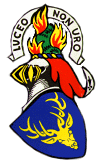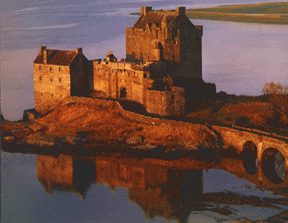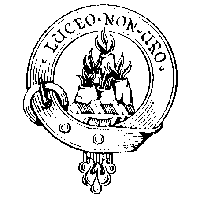
|
MacKenzies on the Net Clan MacKenzie Discussion Area Clan MacKenzie Contacts |

|
MacKenzies on the Net Clan MacKenzie Discussion Area Clan MacKenzie Contacts |


Alexander Mackenzie of Kintail was one of the chiefs who attended the Parliament of 1427; but, as he was very young at the time, James I sent him not to prison but to school at Perth, which was then one of the centers of the Court. Alexander seems to have taken advantage of his education, for he was later called "the Upright" and his rule of the clan laid the foundations of its future power. Alexander refused to support his superior, the Lord of the Isles, in his later rebellions and the Mackenzies were prominent in defending the King. As a result the Chief obtained royal charters for his land, the earliest being in 1463. Thirteen years later as the result of another rebellion, the Earldom of Ross was declared forfeit to the Crown, and in the same year Alexander Mackenzie was given charters of land to be held directly from the King. A last revolt by younger members of the MacDonald family, under Alexander of Lochalsh, was finally crushed, the leader captured by the Mackenzies, and the Lordship of the Isles itself was forfeit in 1493. This enabled the Mackenzies to obtain new land without antagonizing powerful neighbors and, what was perhaps more important, to acquire clear legal titles from their own superior, the Crown.
Alexander's son, Kenneth, married a daughter of Lord Lovat, his son, John married a daughter of Grant of Grant, while his son, another Kenneth, married Lady Elizabeth Stewart, daughter of the Earl of Atholl and niece of the Earl of Argyll. The power resulting from these alliances was seen after the Government of the infant Mary Queen of Scots had appointed the Earl of Huntly to be "Lieutenant of the North," while Argyll held a similar position in the west. In 1544 Huntly commanded Mackenzie of Kintail to raise his clan against Clanranald of Moidart and, when he refused, ordered an attach on Mackenzie. But the clans supporting Huntly - Grants, Rosses, and Macintoshes - were not inclined to fall out with Mackenzie and would not attack him. From that time onwards Kintail seems to have been recognized as a separate power in the northwest, independent of the Queen's Lieutenant. In 1602, John Mackenzie of Kintail was appointed a Privy Councillor and in 1609 he was created Lord Mackenzie of Kintail. His independent power and influence in the north had been fully recognized.
The clan country of the Mackenzies includes almost every kind of scenery and conditions to be found in Scotland. The original home of the clan is Kintail, which in Gaelic means "head of the sea." High hills fall steeply down to Loch Duich, giving little space for cultivation. At the mouth of Loch Duich stands Eilean Donan castle, no longer a stronghold of the Mackenzies, but the first home of their chief. Built on a rocky island at the narrow entrance of the loch, where the arrival of enemy boats could be seen and contested, it looks over the water towards Skye and the west.
From Kintail the Mackenzies gradually pressed outwards. Eventually they reached the east coast and here they found a fertile country where the soil is excellent and the climate most favorable for agriculture. In contrast to the west, the slope from moorland to sea is very gradual, the hills are softly rounded and stand back from the water allowing the cultivation of a wide plain. The coastline runs back into several firths but the rivers flow gently through fields rather than hurl themselves over rocks as they do on the west. Although the Mackenzie country has a shorter coastline on the east, it is far richer. In later years the chiefs moved eastwards from Eilean Donan. In the fifteenth century they lived at Kinellan, near Strathpeffer, before making their home at Brahan, near Dingwall, where, in the early seventeenth century, they built themselves a castle that was as much a contrast to Eilean Donan as the surrounding country was to Loch Duich. Brahan was regarded as one of the most stately houses in Scotland when it was built among the meadows above the river Conon.

In Scottish clans, the younger sons and grandsons of the Chief often founded what were known as cadet or landed families of their own. In the Clan Mackenzie there was an unusual number of these, 25 founded before 1600. After 1600 only five main cadets appeared - Roderick of Coigach, Alexander of Kilcoy, and Alexander of Coul being brothers of Lord Mackenzie, Simon of Lochslin, his son, and John of Gruinard, his great-grandson. These five founded another sixteen landed families within the clan. The descendants of Roderick of Coigach rose to become Earls of Cromartie.
In 1609, as previously described, the Chief was created Lord Mackenzie. Fourteen years later, in further recognition of his power in the north, he became Earl of Seaforth, taking his title from a sea-loch in Lewis. This Earl had succeeded his father at the age of eleven and his affairs were very ably managed by his uncle, Roderick of Coigach, known as the Tutor of Kintail. Coigach was an excellent landlord but severe, as is recorded in the saying, "There are but two things worse than the Tutor of Kintail - frost in spring and mist in the dog days." Under his administration the Mackenzie estates increased in value while the influence of the first Earl was extended by his marriage to Lady Margaret Seton, daughter of the Lord High Chancellor of Scotland. Before the death of the first Earl of Seaforth in 1633, the fortunes of the Mackenzies, chief and clan, were at their highest peak.
Coigach was also able to lay the foundation of the success of his own family. He himself was knighted, his son, Sir John Mackenzie of Tarbat, became a Baronet, while his grandson was created Viscount Tarbat and later Earl of Cromartie. In commemoration of the fact that Coigach, the first property of the family, had been inherited through marriage with the MacLeods of Lewis, Cromartie's son took the title of Lord MacLeod.
The history of the Mackenzies in the seventeenth and eighteenth centuries naturally centers on the fate of the Stewart kings. The struggle opened in the 1630's, when the power and influence of the clan were at their highest. The cause of the trouble in Scotland at first appeared to be purely religious and there were many, including Seaforth, who were unwilling at first to seem disloyal to the Church and the Covenant they had signed for its defense. The Mackenzies therefore wavered during Montrose's campaigns of 1644 and 1645 and it was not until just before the tragedy of the death of Charles I that Seaforth, fully realizing that he must choose between the Covenant and the King, took up the Stewart cause which was ultimately to ruin his family. In 1649, having placed his family in safety in Lewis, Seaforth joined Charles II in exile in Holland.
Seaforth's eldest son ran away from college at Aberdeen to gather recruits from the clan. Several of the cadets followed him to join the King and were present with their men at the battle of Worcester in 1651 when Cromwell defeated Charles. In 1652 this son, now Earl of Seaforth, was among the chiefs who were plotting a rising against Cromwell's government of Scotland. It was Seaforth who opened hostilities in Lewis in May 1653. General Monck eventually defeated the Royalists at Loch Garry. The leaders managed to hold out for several months longer, but in the end they capitulated. The treaty between Cromwell and Seaforth was signed in January 1655 and Seaforth, together with Coul, Applecross and Lochslin, was allowed to go free after providing certain financial security. These seem easy terms but, apart from the loss in man-power sustained by the clan, the lands of Kintail, Lochbroom, Strathgarve, Strathconan, and Strathbran had already been burnt "as a lesson."
The return of Charles II in 1660 brought peace to the Highlands and prosperity to Clan Mackenzie; but twenty-eight years later, when James II fled the country, Seaforth, now the son of the college boy of 1649, went with him. By the time Seaforth had arrived back in Scotland to gather his clan in support of the rising of 1689, Viscount Dundee the Jacobite leader had died at the battle of Killiecrankie and the struggle was over for the time. But King William allowed no chances for further plotting; Seaforth was imprisoned for seven years, and garrisons were placed at Brahan and at Castle Leod, the home of Lord Tarbat. As soon as he was liberated Seaforth returned to the Stuart Court in France, where he died in 1701.
His son William, the 5th Earl, was perhaps the most devoted Jacobite of all his family. Returning to Scotland about 1713, he was soon involved in the plots. In 1715 Seaforth went north to raise his clan, but found his return blocked. It was not until Seaforth had collected about 3000 men, including other clans as well as his own, that he could fight his way south, leaving some of his clan under Coul and Gruinard to hold Inverness. The Mackenzies joined the Jacobite army in time to take part in the battle of Sheriffmuir, where many of them were killed. A few days earlier Coul had been forced to yield Inverness, the garrison was compelled to swear not to bear arms against the Hanoverians and, as a precaution, Brahan was once again occupied, together with Eilean Donan. Seaforth returned north after the defeat at Sheriffmuir and tried to raise another army, but the government forces were too strong and the rising was already fading out elsewhere.
Seaforth himself escaped to France, but his estates, with those of all the landowners who had taken part in the rising, were forfeit. In 1718 a large-scale invasion of England by the Duke of Ormonde was being planned there and it was decided that the Highlanders should create a diversion in the north to draw off some of the Hanoverian troops. Jacobite headquarters were established at Eilean Donan castle in March 1719. But Ormonde's fleet had already been scattered by a gale and the English blew up the castle and set fire to all the supplies. At the beginning of June Seaforth returned from a recruiting drive with at least 500 of his clan only a few days before the Hanoverian army attacked the Jacobites in Glen Shiel. Seaforth and Coul each commanded over 200 Mackenzies, the former on the extreme left and high up the hillside. Seaforth was attacked first and Coul with his men came to help him, but the Jacobite army had already been defeated and the Mackenzies were pursued. Seaforth had been severely wounded at the battle, but he managed to escape once more to France. A week after the battle of Glen Shiel the English commander wrote that he was "taking a tour through all the difficult parts of Seaforth's country to terrify the Rebels by burning the houses of the Guilty."
The inevitable result of all this fighting was not only to reduce the man-power of the clan but also to impoverish those remaining. In 1725 General Wade reported that the Seaforth tenants, who had been among the richest of any in the Highlands, were now poor, through neglecting their business and applying themselves to the use of arms. He might as justly have said that they were poor through having their houses and crops burnt by government troops as a lesson. Seaforth died in 1740 and was succeeded by his son Kenneth, known as Lord Fortrose.
The extreme poverty of the clan and the chief goes far to explain why Lord Fortrose did not lead the clan to the help of Prince Charles Edward in 1745. He decided that he could not again hazard the fortunes of his clan and family and Duncan Forbes of Culloden even managed to persuade him to recruit a few officers for an Independent Company under the Hanoverian government. Meanwhile the Earl of Cromartie and his son, Lord MacLeod, decided to call out the clan and succeeded in raising about 500 men. Cromartie's Regiment, as the force was called, joined the Prince at Stirling in January 1746 and fought at the battle of Falkirk. On 15th April, the day before the battle of Culloden, they were defeated at Dunrobin and the Earl of Cromartie, Lord MacLeod, and many others were taken prisoner.
During the later part of the eighteenth century it seemed as though the family of Mackenzie of Seaforth might again rise to lead the North, but the losses they had suffered eventually proved too heavy. Lord Fortrose died in 1761 and was succeeded by his son, who was once more created Earl of Seaforth. It was this Earl who raised and commanded a regiment of Seaforth Highlanders when the Government decided to seek recruits among the clans for service in the war of American Independence. The 78th Regiment, as it was first called, was raised in 1778 from men on the Seaforth and other Mackenzie estates. The Earl of Seaforth, having raised his men, sailed with them to India in 1781, but unfortunately died there a few month later. He had no son and was succeeded by the descendants of his father's great-uncle, a younger son of the 3rd Earl. This line was represented by Thomas Humberstone Mackenzie, who died within two years of succeeding to the estates, to be followed by his brother Francis.
In Francis Humberstone Mackenzie the clan had one of its ablest chiefs, but even he failed to resuscitate the clan. The vast Seaforth estates provided very little money-rent, the Highlanders were without means to increase this, and the chief lacked the capital needed to undertake the extensive schemes of improvement and development which alone would benefit his people. Many Mackenzies found their way overseas at this time. On his death the estates passed to his elder daughter, whose husband, Admiral Sir Samuel Hood, had recently died while serving in Indian waters. Lady Hood afterwards married James Stewart of Glasserton, grandson of the 6th Earl of Galloway and their son assumed the name of Stewart-Mackenzie, but there were no male heirs in several generations. Colonel James Francis Stewart-Mackenzie was created Baron Seaforth of Brahan in 1921, but this title became extinct on his death 2 years later. His niece, Lady Middleton, had two sons; the elder took the name of Stewart-Mackenzie of Seaforth on succeeding to Brahan, but both were killed in action in 1943.
The Earldom of Cromartie, which was forfeited after 1745, was revived in 1861 in favor of Anne, only daughter of John Hay Mackenzie of Cromartie, whose ancestors had inherited the estates, including Castle Leod in Strathpeffer, from Lord MacLeod. The first Countess was Mistress of the Robes to Queen Victoria and later married the Duke of Sutherland. The Cromartie honors, descending through their second son Lord Tarbat, were confirmed to his daughter Sibell in 1895. After holding them for more than sixty years, she was succeeded in 1962 by her son Roderick Grant Francis Mackenzie as 4th Earl of Cromartie. In 1979 Sir Roderick was confirmed as Caberfeidh (chief) of the Mackenzies. Roderick died December 21, 1989, and his son John R. Mackenzie became Earl of Cromartie, and Caberfeidh.
In 1991, under the leadership of Caberfeidh, the Clan Mackenzie announced plans to restore the original portion of Castle Leod, built at the end of the 15th Century. The restored Castle will include a Clan genealogical center and will be open to the public. The Earl and his family will continue to live in an extension to the Castle built in the Victorian and Edwardian periods.
[This history quotes extensively from "The Clan Mackenzie" by Jean Dunlop, 1953.]






